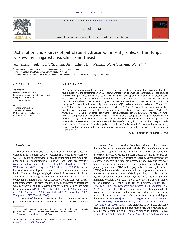摘要
Petroleum-contamination soil is ubiquitous. The various sources of this contamination necessitate the effective evaluation of the contamination level, contaminant transport analysis and identification of the pollution sources. In the present study, soil profiles were collected from both upland and paddy fields along the strike of the irrigation canals in the Hunpu wastewater irrigation region in northeast China. The concentrations of aliphatic hydrocarbons in the soil were analyzed. The sites near the oil wells, wastewater irrigation canal and Shenyang City were found to have high concentrations of [Sigma n-alkanes (sum of n-alkanes): (0.8 to 32.2) mu g g(-1) dry wt.; TAH (total aliphatic hydrocarbons): (5.0 to 161.2)mu g g(-1) dry wt.]. The geochemical analysis results showed various degrees of petroleum pollution. The Sigma n-alkanes varied (0.5 to 7.5) mu g g(-1) while TAH varied (1.6 to 47.2) mu g g(-1) at other sites where biogenic hydrocarbons were dominant. The results from the principal components and redundancy analyses showed that the samples containing hydrocarbons from wastewater irrigation, oil wells, and atmospheric deposition were partitioned into different groups. These results further represented that the soil properties had some effects on hydrocarbon distribution especially the sand content which had significantly negative correlation with oil-related hydrocarbons. The current study showed that the early input and vertical migration of hydrocarbons resulted in a high deep-soil hydrocarbon concentration.
